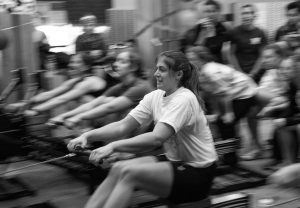
Physical activity and schizophrenia don’t always see eye to eye. There is evidence that physical activity interventions can improve cardio-metabolic outcomes and improve mental health symptoms in people with schizophrenia (Firth et al 2015, Rosenbaum et al, 2014). However, people with psychotic disorders are highly sedentary (Stubbs et al 2015, 2016b) and experience a range of barriers to physical activity.
While there is increasing data about motivational factors and barriers to exercise in psychiatric patients that can help develop effective interventions to increase exercise participation, there is still a great deal of confusion in the literature about how much physical activity psychiatric patients engage in and if they are meeting the recommended physical activity guidelines of 150 minutes of moderate aerobic activity per week.
Thus the subject of today’s blog is a systematic review, meta-analysis and meta-regression that aims to quantify physical activity levels in people with schizophrenia (Stubbs et al 2016a).

This study explored the amount of physical activity that people with schizophrenia actually engage in.
Methods
- The search included articles up to February 2016 in the electronic databases MEDLINE, PsycINFO, and EMBASE. Reference lists of retrieved articles were also searched.
- Studies were eligible for inclusion if they were published in an international peer-reviewed journal or a published dissertation in the English language.
- Eligible studies included adult participants with a diagnosis of schizophrenia spectrum disorder (including first episode psychosis). Studies with mixed samples of mental illness were only included if >80% of the sample had schizophrenia and/or reported data specifically for schizophrenia.
- Eligible studies reported the amount of time of physical activity participation including light, moderate, moderate-vigorous, vigorous physical activity per day with either a self-reported questionnaire (SRQ) or an objective measure. Studies measuring exercise only were not included.
- 2,745 articles were identified (3,719 prior to removal of duplicates). 2,511 articles were excluded after reviewing title and abstract and full text articles were retrieved for 234 articles of which 35 were eligible for inclusion.
- Thus in total 35 studies, comprising 3,453 patients with schizophrenia were eligible for inclusion. Of the 35 studies:
- 12 assessed physical activity using an objective measure
- 1 utilised both objective and subjective measures
- The remaining 22 used a self-reported questionnaire.
Results
- 56.6% (95% CI 45.8 to 66.8, n=646) of patients with schizophrenia met the recommended 150 minutes of moderate physical activity per week
- People with schizophrenia engaged in:
- 80.44 minutes of light physical activity per day (95% CI 68.3 to 92.5, n=2,658)
- 16.2 minutes of moderate physical activity per day (95% CI 11.4 to 21.1, n=2,563)
- 47.1 minutes of moderate-vigorous physical activity per day (95% CI 31.5 to 62.8, n=559)
- And only 1.05 minutes of vigorous physical activity per day (95% CI 0.5 to 1.6, n=2,553).
- For both moderate and vigorous physical activity higher levels of physical activity were reported in SRQ compared to objective measures. In contrast for light physical activity, SRQ reported lower levels compared to objective measures.
- People with schizophrenia (n=213) engaged in less moderate and vigorous physical activity compared to controls (n-156). There were no differences in light physical activity between people with schizophrenia (n=150) and controls (n=101).
- Older patients engaged in more light physical activity and less vigorous physical activity. Patients with depressive symptoms engaged in less vigorous physical activity.

Patients with schizophrenia engaged in less moderate and vigorous exercise when compared with healthy controls.
Conclusions
The purpose of this study was to examine the amount of physical activity that patients with schizophrenia engage in, and also investigate predictors of physical activity in this patient group. Using 35 studies, and data from 3,553 patients Stubbs et al (2016) showed that on average patients with schizophrenia participated in almost 90 minutes of light physical activity per week and more than 45 minutes of moderate-vigorous physical activity. Indeed, more than half of patients with schizophrenia met the recommended 150 minutes of moderate physical activity per week. There was no difference in the amount of light physical activity between people with schizophrenia and controls, however people with schizophrenia engaged in significantly less moderate and vigorous physical activity.
This study showed that depressive symptoms were a predictor for engaging in less vigorous physical activity. This is supported by previous data showing that low mood is a barrier to exercise participation Firth et al (2016).
Older age was a predictor for engaging in more low intensity physical activity, suggesting that light physical activity is more preferable to those with established illness. This is supported by data that shows walking is a preferred method of physical activity in those with psychotic disorders (Fraser et al, 2015; Soundy et al 2014a). In the general population walking can reduce overall cardiovascular risk (Hanson and Jones, 2015). Thus the data in this study would suggest that walking may be a popular and effective intervention in older people with schizophrenia.

These are promising findings but more needs to be done to promote physical activity in people with severe mental illness.
Strengths and limitations
The results of this large study are novel and greatly contribute to the field by being one of few studies to actually quantify physical activity participation in patients with schizophrenia. However, for some analyses there were a relatively limited number of studies, reducing the strength of the data.
Another limitation of this study is the differences in physical activity between subjective and objective measures. Variation in mood may influence the ability to accurately respond to SRQ (Soundy et al 2014b) and as patients with schizophrenia are significantly less physically fit than the general population (Vancampfort et al 2015, 2016) patients may perceive moderate intensity physical activity as vigorous. Thus in psychiatric patients the use of SRQ data may not be reliable, highlighting the need for increased use of objective measures of physical activity in future research.
The authors also highlighted that while 95% of participants were taking antipsychotic medication, there was inadequate information on this, precluding any analysis of this on physical activity. In addition, there was a lack of data from younger patients. Thus the data in this study may not be applicable to younger patients with schizophrenia and it is unclear what effect antipsychotic medication may have on physical activity.

Physical activity interventions need to be tailored to different age groups and more needs to be done to encourage participation in moderate-vigorous physical activity.
Summary
- Date from this large systematic review, meta-analysis and meta-regression show that patients with schizophrenia engage in less moderate and vigorous physical activity compared to controls, but there were no differences in the amount of light physical activity.
- Increasing age and depressive symptoms predicted reduced vigorous physical activity and increasing age also predicted increased participation in light physical activity.
- Future interventions targeting light physical activity such as walking may allow older people with schizophrenia to experience the health benefits of physical activity.
- Further research is required to investigate physical activity in younger patients with schizophrenia and the effect that antipsychotic medication has on physical activity and should use of objective measures of physical activity to avoid the effects of mood variation and baseline physical fitness on subjective measures.

Targeting light physical activity such as walking may be an effective intervention in older patients.
Links
Primary paper
Stubbs B, Firth J, Berry A et al (2016a) How much physical activity do people with schizophrenia engage in? A systematic review, comparative meta-analysis and meta-regression. Schizophr Res. 2016 Oct;176(2-3):431-40. [PubMed Abstract]
Other references
Firth J, Cotter J, Elliott R et al (2015) A systematic review and meta-analysis of exercise interventions in schizophrenia patients. Psychol Med. 2015 May;45(7):1343-61 [PubMed Abstract]
Firth J, Rosenbaum S, Stubbs B et al (2016) Motivating factors and barriers towards exercise in severe mental illness: a systematic review and meta-analysis. Psychol Med. 2016 Aug 9:1-13
Fraser SJ, Chapman JJ, Brown WJ et al (2015) Physical activity attitudes and preferences among inpatient adults with mental illness. Int J Ment Health Nurs. 2015 Oct;24(5):413-20 [PubMed Abstract]
Hanson S, Jones A (2015) Is there evidence that walking groups have health benefits? A systematic review and meta-analysis. Br J Sports Med. 2015 Jun;49(11):710-5
Rosenbaum S, Tiedemann A, Sherrington C et al (2014) Physical activity interventions for people with mental illness: a systematic review and meta-analysis. J Clin Psychiatry. 2014 Sep;75(9):964-74 [PubMed Abstract]
Soundy, A., Muhamed, A., Stubbs, B et al (2014a). The benefits of walking for individuals with schizophrenia spectrum disorders: a systematic review (PDF) Int. J. Ther. Rehabil. 2014, 21 (9), 410–420.
Soundy A, Roskell C, Stubbs B et al (2014b) Selection, use and psychometric properties of physical activity measures to assess individuals with severe mental illness: a narrative synthesis. Arch Psychiatr Nurs. 2014 Apr;28(2):135-51 [PubMed Abstract]
Stubbs B, Gardner-Sood P, Smith S et al (2015) Sedentary behaviour is associated with elevated C-reactive protein levels in people with psychosis. Schizophr Res. 2015 Oct;168(1-2):461-4. [PubMed Abstract]
Stubbs B, Williams J, Gaughran F et al (2016b) How sedentary are people with psychosis? A systematic review and meta-analysis. Schizophr Res. 2016 Mar;171(1-3):103-9. [PubMed Abstract]
Vancampfort D, Rosenbaum S, Probst M et al (2015) Promotion of cardiorespiratory fitness in schizophrenia: a clinical overview and meta-analysis. Acta Psychiatr Scand. 2015 Aug;132(2):131-43 [PubMed Abstract]
Vancampfort D, Stubbs B, Sienaert P et al (2016) A comparison of physical fitness in patients with bipolar disorder, schizophrenia and healthy controls. Disabil Rehabil. 2016 Oct;38(20):2047-51 [PubMed Abstract]
Photo credits
By Walking for Health Paul Glendell / Natural England (originally posted to Flickr as WfH Epsom Aug 09_14) [CC BY-SA 2.0], via Wikimedia Commons

Physical activity and schizophrenia: how much exercise do people do? https://t.co/VqjCOi3tT8
How much #PhysicalActivity do people with #Schizophrenia engage in?
Today @StarryJojo on recent systematic review https://t.co/8DE2V3KQyZ
@Mental_Elf @MHARG_york @StarryJojo Depends how often supports+ loved ones visit them+ take them out b/c they haven’t got cash 2 do anything
@Mental_Elf @StarryJojo Hows that for a systematic review. Pretty much sums that one up in a nut shell without out all your expensive tests
@Mental_Elf @StarryJojo People who have loved ones whom r mentally ill have 2 stop stigmatizing them and go visit them 1 to 2 times a week.
@Mental_Elf @StarryJojo All your programs+ money u put into helping….all of it doesn’t work without family’s understanding of the illness.
@Mental_Elf @StarryJojo in my hospital, nearly 0, “they don’t need it”, says the fat nurse.
Physical activity and schizophrenia: how much exercise do people do? https://t.co/PW3uCmjvKW via @sharethis
Physical activity and schizophrenia: how much exercise do people do?: Int J Ment Health Nurs. 2015 Oct;24(5):… https://t.co/z6dZ1F5MQg
check out my blog @Mental_Elf about how much exercise people with schizophrenia actually do https://t.co/hlEoUCPdEm
Hello!
@BrendonStubbs @joefirth7 @simon_rosenbaum @DavyVancampfort
Physical activity & schizophrenia
Read our blog!… https://t.co/osLo1BRMXK
Physical activity and schizophrenia: how much exercise do people do?: Int J Ment Health Nurs. 2015 Oct;24(5):… https://t.co/jxccqzKjdS
Physical activity and schizophrenia: how much exercise do people do? – from @Mental_Elf https://t.co/3Igc7jB8ge
@Mental_Elf I remember Stockport PCT (remember them?) used to do football on px with Stockport County Football Club
Physical activity and schizophrenia: how much exercise do people do? https://t.co/Y0JFvrD2nL
Physical activity and schizophrenia: how much exercise do people do?: Int J Ment Health Nurs. 2015 Oct;24(5):… https://t.co/UCU97P6fl3
Physical activity and schizophrenia: how much exercise do people do? https://t.co/BmpwpRFiG2 via @sharethis
Physical activity and schizophrenia: how much exercise do people do? https://t.co/bnuhKrPZjt via @sharethis
Physical activity and schizophrenia: how much exercise do people do? https://t.co/bYmzDHw2jE via @sharethis
Physical activity and schizophrenia
How much exercise do people do?
https://t.co/8DE2V3KQyZ https://t.co/46gRBcoDLp
Physical activity and schizophrenia: how much exercise do people do? https://t.co/8Rn5bqbj2k via @sharethis
Physical activity and schizophrenia: how much exercise do people do? https://t.co/9q0DYckiIt via @sharethis